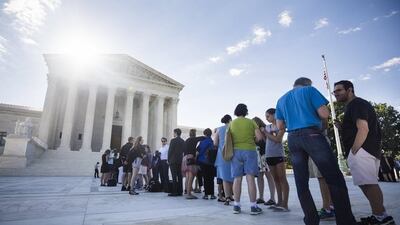Washington // The US supreme court has partially reinstated president Donald Trump’s travel ban targeting citizens from six predominantly Muslim countries, but said it would examine the case in full in October.
The court ruled on Monday that the ban could be enforced for travellers from Iran, Libya, Somalia, Sudan, Syria and Yemen "who lack any bona fide relationship with a person or entity in the United States".
However, the ban – which was put on hold by lower courts – cannot be implemented for now against people who have personal links to the United States, the judges said, citing the examples of foreign nationals wishing to visit family or students accepted to attend a university.
The decision nonetheless marks a win for Mr Trump, who has insisted the ban is necessary for national security, despite criticism that it singles out Muslims in violation of the US constitution.
"Today’s unanimous supreme court decision is a clear victory for our national security," Mr Trump said. "It allows the travel suspension for the six terror-prone countries and the refugee suspension to become largely effective. As president, I cannot allow people into our country who want to do us harm."
The president said last week that the ban would take effect 72 hours after being cleared by courts.
Mr Trump suffered a series of judicial setbacks over his proposed entry restrictions. His original measure, issued by executive order in January, was almost immediately blocked by the courts. It sought to bar entry to travellers Iran, Iraq, Libya, Somalia, Sudan, Syria and Yemen for 90 days, suspend the entry of refugees from Syria indefinitely, and for 120 days for refugees from other countries.
The president issued a revised order in March that dropped Iraq from the list of targeted countries and the indefinite ban on Syrian refugees.
The Trump administration says the ban is needed to prevent terror attacks in the country, and that it needs the time allowed by the ban to evaluate existing screening protocols and set new ones.
But courts ruled that because it applied selectively to mainly Muslim countries, the ban violated the US Constitution’s ban on religious discrimination.
While the ban itself did not single out Muslims, judges cited Mr Trump’s repeated statements during last year’s presidential race that he intended to ban Muslims from entering the United States.
The supreme court ruling narrowed the scope of injunctions that lower courts placed on the ban, saying the government could enforce its measure against "foreign nationals unconnected to the United States" without causing injury to the parties who filed suit.
Mr Trump’s failure to impose his travel bans had left in limbo a key campaign promise by the Republican to crack down on immigration from Muslim countries.
The countries targeted were on a list from the previous Obama administration of places where the governments had very poor data on their own citizens, making it difficult to vet the identities of visa applicants.
The justicedepartment filed an emergency application to the supreme court on June 1, urging it to undo two lower court rulings. The White House argued that the US president has the power to set immigration policy, especially on national security grounds.
The review of screening procedures for visa applicants from the six countries, for which the administration had sought the 90-day travel ban, should be complete before the supreme court begins its new term on October 2.
Even without the ban in place, arrivals from these countries has dropped sharply, in part due to the "extreme vetting" approach of US authorities, toughening their scrutiny of visa applicants.
Arrivals from Iran, Libya, Somalia, Sudan, Syria and Yemen were down by nearly half in March and April from a year ago – 6,372 for the two months compared to 12,100 in 2016, according to recent official data.
* Agence France-Presse

